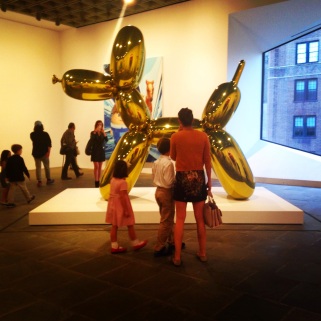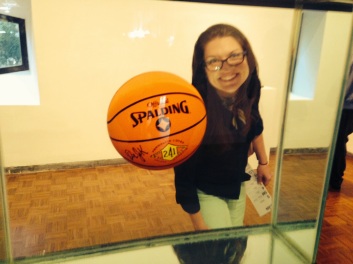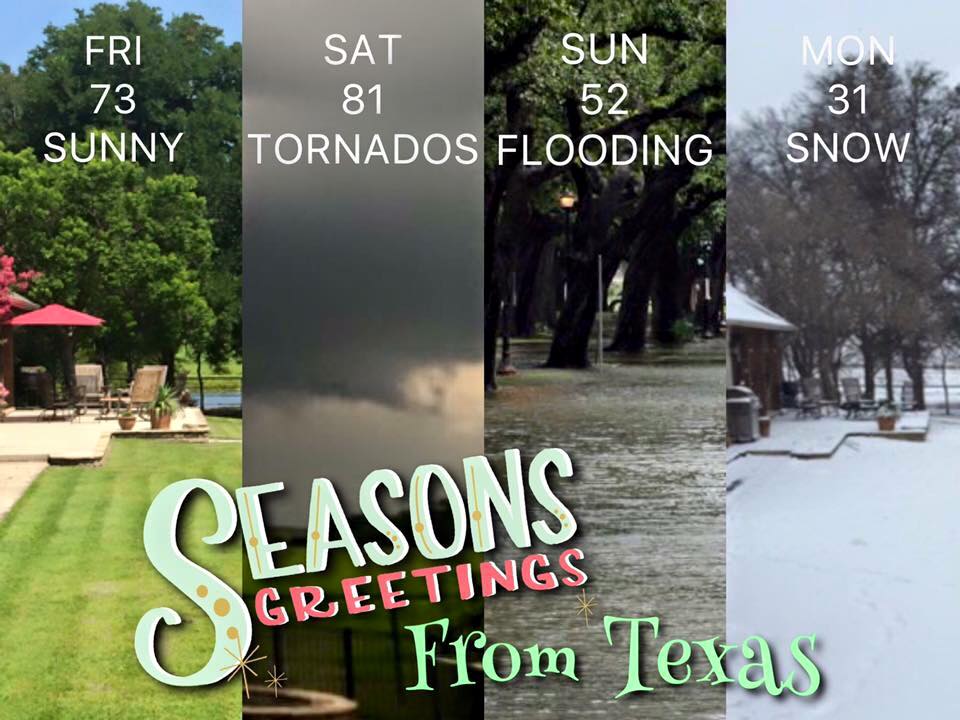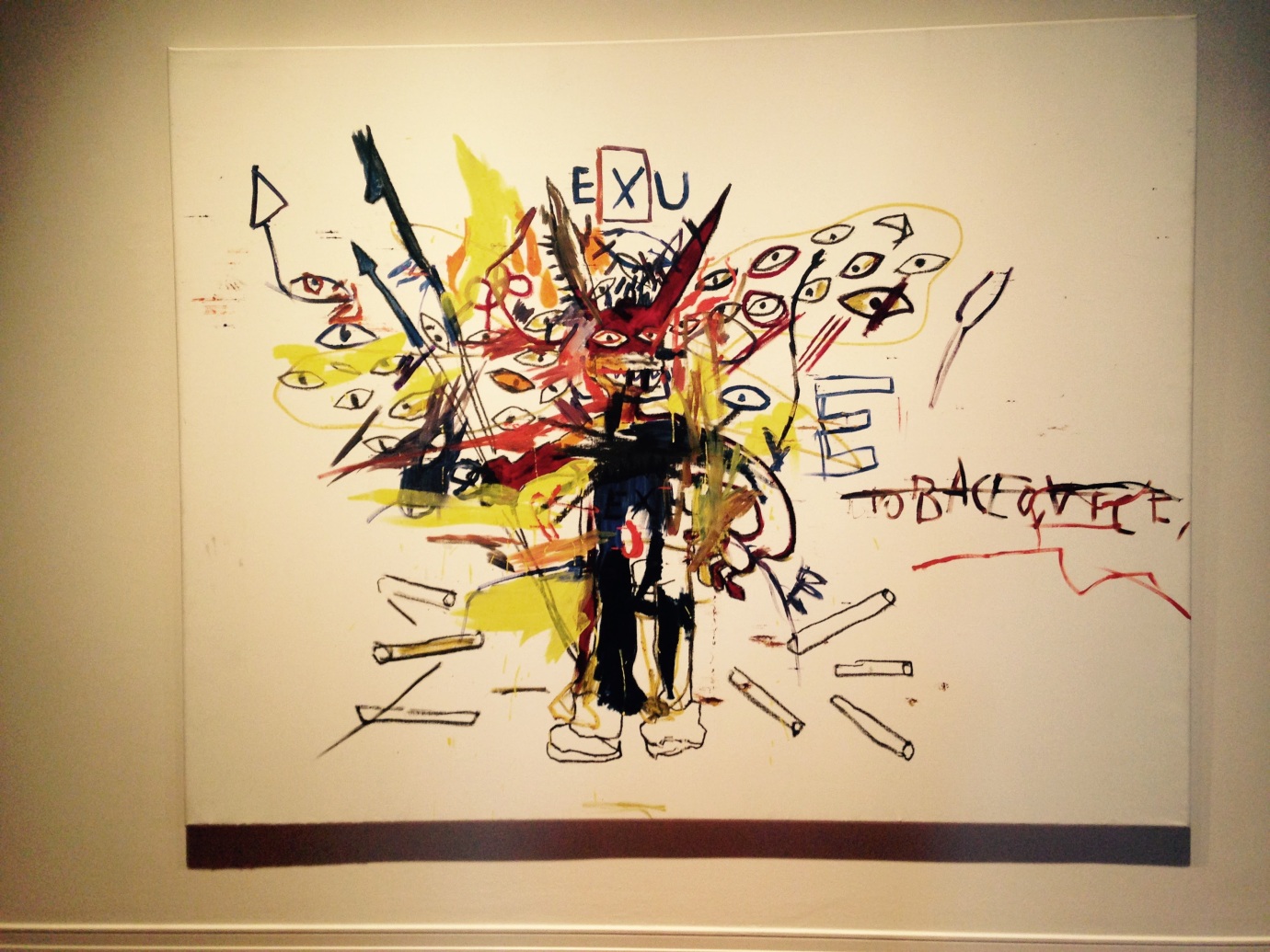It started with a movie, “Basquiat,” a bio-pic starring Jeffrey Wright, that came out when I was in high school. The charisma and mystique of the real-life character of Jean-Michel Basquiat as portrayed by that actor plus a great supporting cast (Gary Oldman, David Bowie, among others) at that impressionable age, got me interested in the work of Basquiat. I didn’t really “get” the art itself at the time, it seemed so scribbly.
So for many years I have had a soft spot in my heart for Basquiat because of the film, but never further than that, no real understanding of the work, just the artist as character. Fast-forward to October 2014 when I rushed to the Whitney Museum to catch the last days of their last exhibition programmed for the Marcel Breuer building: Jeff Koons. I made it to the show, I saw celebrities in line, I bumped into a good friend, all in all it was a great visit to the museum.
One of the greatest things about it was finding the variety of permanent collection works on display on the top level, after many floors of Koons. The exhibition of collection gems was the perfect palate cleanser after the balloon & toy explosion on the lower floors. After a museum-full of these kinds of things:

Kids enjoying art: say what you will about Koons, the young ‘uns loved it!

Museum “selfie” with the most famous art basketball. Photo by Kara Meyer.
I came up and got some air at the top of the Bauhaus behemoth. After a couple of turns, there it was.

Jean-Michel Basquiat, “Hollywood Africans” 1983, Whitney Museum of American Art, New York; Gift of Douglas S. Cramer. Thank you Douglas S. Cramer, thank you.
I had never seen “Hollywood Africans” before and it hit me, “This is why people love him!” I spent at least 20 minutes on this work alone. In retrospect, maybe I never really got Basquiat before because I’d never seen his work in person? But seeing this field of rich yellow and the strong striking contrasts of the cobalt blue and red and black messages was like nothing I’d seen. Fantastic.
Soon after that, I read a review in Hyperallergic of an exhibition put on as part of Prospect.3 in New Orleans. Upon reading, I was seriously interested in seeing the show, Basquiat and the Bayou, curated by P.3 creative director Franklin Sirmans. Hmm, how to work this? I was living in NYC, that bi/triennial was in New Orleans. I had tried to talk my husband into going to see Prospect.1 in 2008 on a road trip to Texas but we skipped it at the last minute to spend more time with the family we were going to go visit.
And then we decided to drive to Texas again, in 2014 for Christmas and entering the new year of 2015. Okay! My plan-averse husband didn’t have any big ideas for the trip, just that we wanted to see our families, we wanted them to see our darling son, and that we wanted our dear dog to come along. Plans came together, and in all the discussions I inserted my desire (nay, my need) to go see that show, every. single. time. it came up.

Road trip entertainment tips: sock puppets. Dog is unimpressed.
We had an impressively easy journey down and some wonderful time with family and friends. Then it took us an inordinately long time to get ourselves to New Orleans once we set out for that leg of the trip. After many days trekking around Texas to see our people with no problems at all, the cruddy rainy weather and terrible traffic made a 5-hour drive into an 8 hour one. It started to seem like I was being punished for doing something just for us (OK, me) before we headed back to Brooklyn. We finally made it and had a late dinner at our hotel, which was literally around the corner from the museum that housed the show, the Ogden. That was a stroke of genius; I’d considered booking a different hotel, closer to other shows and cool things in NOLA, but went with the Modern and I’m so very glad.
I had hoped to get to the museum bright and early, but a 40-year-old husband and a 16-month-old child make their own time. Once we got there it was as I had hoped, phenomenal.

Jean-Michel Basquiat, “Zydeco” (1984). Installation view in “Basquiat and the Bayou” at the Ogden Museum of Southern Art, New Orleans. Photo by John d’Addario.
On the wall of the hallway leading to the exhibition was an extensive timeline of Basquiat’s life. In those moments of reading about Basquiat’s short time in the world it was like the grief of his death was finally (or starting?) to sink in. God, what might his work have been like in his later years? And it was affecting me in a different way too, as I lost my youngest brother to a heroin overdose less than a year before. And so the reality of the universe losing a bright star due to drugs really, truly hit home.
The show was tight and very carefully lit, an excellent touch. It was a quiet Sunday when we went in, but more and more people arrived as I cruised the gallery a second and third time. There was also an exhibition of Herbert Singleton’s wood carvings in an adjacent gallery, a very nice compliment.
I was in such a daze the rest of our visit, high on art. We saw a lot of great stuff at that little museum, an extensive local collection of “outsider” art, a permanent collection galleries with both new and familiar names, and I snapped up the last catalogue of the show on the shelf (the clerk assured me there were more in storage). We didn’t end up seeing any other shows in P.3, even at the Contemporary Art Center across the street, but I was still satisfied. That one show, those 9 paintings plus the pleasant Ogden, made that trek to New Orleans worthwhile to me. Big thanks to John d’Addario for the review that led me there.
We did also get to go to the build shed of Krewe du Vieux (links to image search, possibly NSFW) with floats in various stages of construction. I love New Orleans!

Bonus shot: Baby’s first beignets.









